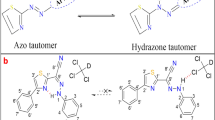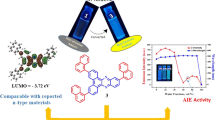Abstract
In here, we investigated the required theoretical and experimental physical characteristics such as potential energy surface scan, optimized structure, vibrational spectra, electronic band structure, molecular electrostatic potential surface, optical and optoelectronic behaviors of the tris[4-(diethylamino)phenyl] amine (TDAPA) for different solvents (DMF and chloroform) and techniques (experimental and theoretical). We obtained the significant, interesting, same and different results for them. We obtained the refractive indices of the TDAPA for various conditions. The TDAPA exhibits a normal dispersion behavior in visible region. TDAPA organic material is suitable for optoelectronic devices and applications such as metal–organic semiconductor diodes due to the appropriate properties.






Similar content being viewed by others
References
S. Reineke, F. Linder, G. Schwartz, N. Seidler, K. Walazer, B. Lüssem, K. Leo, White organic light-emitting diodes with fluorescent tube efficiency. Nature 459, 234 (2009)
F. So, J. Kido, P. Burrows, Organic light-emitting devices for solid-state lighting. MRS Bull 33, 663 (2008)
T. Nakayama, K. Hiyama, K. Furukawa, H. Ohtani, Development of phosphorescent white OLED with extremely high power efficiency and long lifetime. J. SID 16(2), 231–236 (2008). https://doi.org/10.1889/1.2841855
J. Chen, F. Zhao, D. Ma, Hybrid white OLEDs with fluorophors and phosphors. Mater. Today 17, 175 (2014)
J. Lee, W.J. Sung, C.W. Joo, H. Cho, N.S. Cho, G.-W. Lee, D.-H. Hwang, J.-I. Lee, Simplified bilayer white phosphorescent organic light-emitting diodes. ETRIJ 38, 260 (2016)
F. Wudl, G. Srdanov, US Patent 51,891,36A, 1993
A. Ltaief, A. Bouazizi, J. Davenas, R.B. Chaabane, H.B. Ouada, Electrical and optical properties of thin films based on MEH-PPV/fullerene blends. Synth. Met. 147, 261 (2004)
B. Geffroy, P. Roy, C. Prat, Review organic light-emitting diode (OLED) technology:materials, devices and display technologies. Polym. Int. 55, 572–582 (2006)
A. Cravino, P. Leriche, O. Alévêque, S. Roquet, J. Roncali, Light-emitting organic solar cells based on a 3d conjugated system with internal charge transfer. Adv. Mater. 18, 3033–3037 (2006)
Y. Shirota, Photo- and electroactive amorphous molecular materials molecular design, syntheses, reactions, properties, and applications. J. Mater. Chem. 15, 75–93 (2005)
M.M. Stylianakis, J.A. Mikroyannidis, Q.F. Dong, J.N. Pei, Z.Y. Liu, W.J. Tian, Synthesis, photophysical and photovoltaic properties of star-shaped molecules with triphenylamine as core and phenylethenylthiophene or dithienylethylene as arms. Sol. Energy Mater. Sol. Cells 93, 1952–1958 (2009)
M. Zhang, Z. Wu, Q. Wang, Q. Song, Y. Ding, Synthesis and properties of a new [60] fullerene-donor system containing dicyanovinyl groups. Mater. Lett. 64, 2244–2246 (2010)
Y.J. Shirota, Organic materials for electronic and optoelectronic devices. Mater. Chem. 10(1), 1–25 (2000)
K. Walzer, B. Maennig, M. Pfeiffer, K. Leo, Highly efficient organic devices based on electrically doped transport layers. Chem. Rev. 107, 1233–1271 (2007)
H.P. Zeng, T.T. Wang, S.D. Sandanayaka, Y. Araki, O.J. Ito, Photoinduced charge separation and charge recombination in [60]fullerene-ethylcarbazole and [60]fullerene-triphenylamines in polar solvents. J. Phys. Chem. A 109, 4713–4720 (2005)
P. Drzaic, D. Hecht, M. O’Connell, G. Irvin, US Patent 2009/0169819 A1, 2009
M.J. Frisch, G.W. Trucks, H.B. Schlegel, G.E. Scuseria, M.A. Robb, J.R. Cheeseman, G. Scalmani, V. Barone, B. Mennucci, G.A. Petersson, H. Nakatsuji, M. Caricato, X. Li, H.P. Hratchian, A.F. Izmaylov, J. Bloino, G. Zheng, J.L. Sonnenberg, M. Hada, M. Ehara, K. Toyota, R. Fukuda, J. Hasegawa, M. Ishida, T. Nakajima, Y. Honda, O. Kitao, H. Nakai, T. Vreven, J.A. Montgomery Jr., J.E. Peralta, F. Ogliaro, M. Bearpark, J.J. Heyd, E. Brothers, K.N. Kudin, V.N. Staroverov, R. Kobayashi, J. Normand, K. Raghavachari, A. Rendell, J.C. Burant, S.S. Iyengar, J. Tomasi, M. Cossi, N. Rega, J.M. Millam, M. Klene, J.E. Knox, J.B. Cross, V. Bakken, C. Adamo, J. Jaramillo, R. Gomperts, R.E. Stratmann, O. Yazyev, A.J. Austin, R. Cammi, C. Pomelli, J.W. Ochterski, R.L. Martin, K. Morokuma, V.G. Zakrzewski, G.A. Voth, P. Salvador, J.J. Dannenberg, S. Dapprich, A.D. Daniels, O. Farkas, J.B. Foresman, J.V. Ortiz, J. Cioslowski, D.J. Fox (2009) Gaussian 09, revision A.02. Gaussian Inc, Wallingford, CT
E.B. Sas, M. Kurt, M. Can, N. Horzum, A. Atac, Spectroscopic studies on 9H-Carbazole-9-(4-phenyl) boronic acid pinacol ester by DFT method. J. Mol. Struct. 1118, 124–138 (2016)
B. Gündüz, Effects of molarity and solvents on the optical properties of the solutions of tris[4-(5-dicyanomethylidenemethyl-2-thienyl)phenyl]amine (TDCV-TPA) and structural properties of its film. Opt. Mater. 36(2), 425–436 (2013)
C. Orek, B. Gündüz, O. Kaygili, N. Bulut, Electronic, optical, and spectroscopic analysis of TBADN organic semiconductor: experiment and theory. Chem. Phys. Lett. 678, 130–138 (2017)
M. Kurban, B. Gündüz, Physical and optical properties of DCJTB dye for OLED display applications: experimental and theoretical investigation. J. Mol. Struct. 1137, 403–411 (2017)
S.B. Aziz, O. Gh.Abdullah, M.A. Rasheed, A novel polymer composite with a small optical band gap: new approaches for photonics and optoelectronics. J. Appl. Polym. Sci. 134, 44847 (2017)
M.M. El-Nahass, A.M. Farid, A.A. Atta, Structural and optical properties of Tris(8-hydroxyquinoline) aluminum (III)(Alq3) thermal evaporated thin films. J. Alloy Compd. 507, 112–119 (2010)
M. Cabuk, B. Gündüz, Controlling the optical properties of polyaniline doped by boric acid particles by changing their doping agent and initiator concentration. Appl. Surf. Sci. 424, 345–351 (2017)
R.H. French, J.M. R-Parada, M.K. Yang, R.A. Derryberry, N.T. Pfeiffenberger, Optical properties of polymeric materials for concentrator photovoltaic systems. Sol. Energy Mater. Sol. Cells 95, 2077–2086 (2011)
S.B. Aziz, M.A. Rasheed, A.M. Hussein, H.M. Ahmed, Fabrication of polymer blend composites based on [PVA-PVP](1–x):(Ag2S)x (0.01 ≤ x ≤ 0.03) with small optical band gaps: structural and optical properties. Mater. Sci. Semicond. Process. 71, 197–203 (2017)
S.K. Tripathy, Refractive indices of semiconductors from energy gaps. Opt. Mater. 46, 240–246 (2015)
M.S.S. Rahman, M.K. Alam, Effect of angle of incidence on the performance of bulk heterojunction organic solar cells: a unified optoelectronic analytical framework. AIP Adv. (2017). https://doi.org/10.1063/1.4985049.
G. Dennler, K. Forberich, M.C. Scharber, C.J. Brabec, I. Tomiˇs, K. Hingerl, T. Fromherz, Angle dependence of external and internal quantum efficiencies in bulk-heterojunction organic solar cells. J. Appl. Phys. 102, 054516 (2007)
A. Meyer, H. Ade, The effect of angle of incidence on the optical field distribution within thin film organic solar cells. J. Appl. Phys. 106, 113101 (2009)
S. Lee, I. Jeong, H.P. Kim, S.Y. Hwang, T.J. Kim, Y.D. Kim, J. Jang, J. Kim, Effect of incidence angle and polarization on the optimized layer structure of organic solar cells. Sol. Energy Mater. Sol. Cells 118, 9 (2013)
F. Abelès (ed.), Optical Properties of Solids (North-Holland, Amsterdam, 1972)
S. Adachi, Optical Constants of Crystalline and Amorphous Semiconductors: Numerical Data and Graphical Information, (Kluwer Academic Publishers, London, 1999)
B. Gündüz, Optical properties of poly[2-methoxy-5-(3′,7′-dimethyloctyloxy)-1,4-phenylenevinylene] light-emitting polymer solutions: effects of molarities and solvents. Polym. Bull. 72(12), 3241–3267 (2015)
E.B. Sas, M. Cevik, M. Kurt, Experimental and theoretical analysis of 2-amino 1-methyl benzimidazole molecule based on DFT. J. Mol. Struct. 1149, 882–892 (2017)
H. Ulla, M.R. Kiran, B. Garudachari, T.N. Ahipa, K. Tarafder, A.V. Adhikari, G. Umesh, M.N. Satyanarayan, Blue emitting 1,8-naphthalimides with electron transport properties for organic light emitting diode applications. J. Mol. Struct. 1143, 344–354 (2017)
E. Scrocco, J. Tomasi, Electronic molecular structure, reactivity and intermolecular forces: an euristic interpretation by means of electrostatic molecular potentials. Adv. Quantum Chem. 11, 115–121 (1978)
C. Muñoz-Caro, A. Niño, M.L. Sement, J.M. Leal, S. Ibeas, Modeling of protonation processes in acetohydroxamic acid. J. Org. Chem. 65, 405–410 (2000)
P. Politzer, K.C. Daiker, Chap. 6. Models for chemical reactivitiy, ed. by D.M. Deb. The Force Concept In Chemistry, (Van Nostrand Reinhold Co., New York, 1981)
P. Politzer, P.R. Laurence, K. Jayasuriya, J. McKinney, Structure activity correlation in mechanism studies and predictive toxicology. Spec. Issue Environ. Health Perspect. 61, 191 (1985)
Acknowledgements
This work was supported by Ahi Evran University Scientific Project Unit (BAP) with, Project No: PYO–FEN.4001.15.012.
Author information
Authors and Affiliations
Corresponding author
Electronic supplementary material
Below is the link to the electronic supplementary material.
Rights and permissions
About this article
Cite this article
Tanış, E., Babur Sas, E., Gündüz, B. et al. Required theoretical and experimental physical characteristics of tris[4-(diethylamino)phenyl] amine organic material. J Mater Sci: Mater Electron 29, 16111–16119 (2018). https://doi.org/10.1007/s10854-018-9700-1
Received:
Accepted:
Published:
Issue Date:
DOI: https://doi.org/10.1007/s10854-018-9700-1




